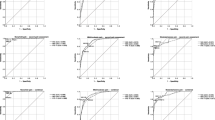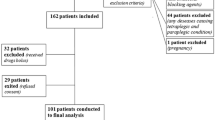Abstract
Objective
This prospective observational study was undertaken in order to assess pain experienced by intensive care unit patients at the time of extubation and to identify factors associated with pain of at least moderate intensity.
Design
Prospective observational study.
Setting
Intensive care unit at a university hospital.
Patients
During a 1-year period the presence, severity and clinical predictors of orofacial and/or chest pain among patients undergoing removal of endotracheal tubes was assessed.
Measurements and results
Pain was evaluated using a visual analogue scale (VAS). Of 332 extubated patients, 203 could be evaluated. During the peri-extubation period, pain was significantly associated with a SAPS II score more than 36 (p=0.03) and duration of mechanical ventilation (MV) of 6 days or more (p=0.002), whereas intubation in the operating room was associated with less pain (p=0.001). Pain of at least moderate intensity (VAS score >30 mm) was reported by 73% of patients and pain of severe intensity (VAS score >50 mm) was reported by 45% of patients. MV duration of 6 days or more was the only independent risk factor for pain of at least moderate intensity (OR 2.4, 95% CI 1.03–5.4, p=0.04). We also observed that pain had resolved 1 h after extubation in the majority of patients.
Conclusion
Our results suggest that, in intensive care unit patients, peri-extubation pain is frequent and should be considered for treatment, especially in patients with longer intubation.

Similar content being viewed by others
References
Stauffer JL, Olson DE, Petty TL (1981) Complications and consequences of endotracheal intubation and tracheotomy. A prospective study of 150 critically ill adult patients. Am J Med 70:65–76
Rashkin MC, Davis Terry (1986) Acute complications of endotracheal intubation. Relationship to reintubation, route, urgency and duration. Chest 89:165–167
Chevron V, Menard JF, Richard JC, Girault C, Leroy J, Bonmarchand G (1998) Unplanned extubation: risk factors of development and predictive criteria for reintubation. Crit Care Med 26:1409–1053
Hartley M, Vaughan RS (1993) Problems associated with tracheal extubation. Br J Anaesth 71:561–568
Huskisson EC (1983) Visual analogue scales. In: Melzack R (ed) Pain measurement and assessment. Raven Press, New York, p 33
Scott J, Huskisson EC (1979) Accuracy of subjective measurements made with or without previous scores: an important source of error in serial measurements of subjective states. Ann Rheum Dis 38:558–559
Slutsky AS (1993) American College of Chest Physicians Consensus Conference. Mechanical Ventilation. Chest 104:1833–1859
Esteban A, Alia I, Tobin MJ, Gil A, Gordo F, Vallverdu I, Blanch L, Bonet A, Vazquez A, De Pablo R, Torres A, De La Cal MA, Macias S (1999) Effect of spontaneous breathing trial duration on outcome of attempts to discontinue mechanical ventilation. Am J Respir Crit Care Med 159:512–518
Collins SL, Moore RA, McQuay HJ (1997) The visual analogue pain intensity scale: what is moderate pain in millimetres? Pain 72:95–97
Prod’hom G, Leuenberger P, Koerfer J, Blum A, Chiolero R, Schalle MD, Perret C, Spinnler O, Blondel J Siegrist H (1994) Nosocomial pneumonia in mechanically ventilated patients receiving antacid, ranitidine, or sucralfate as prophylaxis for stress ulcer. Ann Intern Med 120:653–662
Baker AM, Meredith JW, Haponik EF (1996) Pneumonia in intubated trauma patients: microbiology and outcomes. Am J Respir Crit Care Med 153:343–349
Navarro RM, Baughman VL (1997) Lidocaine in the endotracheal tube cuff reduces postoperative sore throat. J Clin Anesth 9:394–397
Monroe MC, Gravenstein N, Saga-Rumley S (1990) Postoperative sore throat: effect of oropharyngeal airway in orotracheally intubated patients. Anesth Analg 70:512–516
Mandoe H, Nikolajsen L, Lintrup U, Jepsen D, Molgaard J (1992) Sore throat after endotracheal intubation. Anesth Analg 74:897–900
Desbiens NA, Wu AW, Broste SK, Wenger NS, Connors AF, Lynn J, Yasui Y, Phillips RS, Fulkerson W (1996) Pain and satisfaction with pain control in seriously ill hospitalized adults: Findings from the SUPPORT research investigations. Crit Care Med 24:1953–1961
Simini B (1999) Patients’ perceptions of intensive care. Lancet 354:571–572
Bergbom-Enberg I, Haljamäe H (1989) Assessment of patients’ experience of discomforts during respirator therapy. Crit Care Med 17:1068–1072
Rotondi AJ, Chelluri L, Sirio C, Mendelsohn A, Schultz R, Belle S, Im K, Donahoe M, Pinsky MR (2002) Patients’ recollections of stressful experiences while receiving prolonged mechanical ventilation in an intensive care unit. Crit Care Med 30:746–752
Kremer E, Atkinson JH, Ignelzi RJ (1981) Measurement of pain: patient preference does not confound pain measurement. Pain 10:241–248
Jensen MP, Karoly P, Braver S (1987) The measurement of clinical pain intensity: a comparison of six methods. Pain 27:117–126
Harkins SW, Price DD, Braith J (1989) Effects of extraversion and neuroticism on experimental pain, clinical pain, and illness behavior. Pain 36:209–218
Thomas T, Robinson C, Champion D, McKell M, Pell M (1998) Prediction and assessment of the severity of postoperative pain and of satisfaction management. Pain 75:177–185
Berthier F, Potel G, Leconte P, Touze MD, Baron D (1998) Comparative study of methods of measuring acute pain intensity in an emergency department. Am J Emerg Med 16:132–136
Chapman CR, Casey KL, Dubner R, Foley KM, Gracely RH, Reading AE (1985) Pain measurement: an overview. Pain 22:1–31
Benhamou D (1998) Evaluation de la douleur postopératoire. Ann Fr Anesth Réanim 17:555–572
Price DD, Harkins SW, Baker C (1987) Sensory-affective relationships among different types of clinical and experimental pain. Pain 28:297–307
Combes X, Schauvliege F, Peyrouset O, Motamed C, Kirov K, Dhonneur G, Duvaldestin P (2001) Intracuff pressure and tracheal morbidity. Influence of filling cuff pressure with saline during nitrous oxide anesthesia. Anesthesiology 95:1120–1124
McHardy FE, Chung F (1999) Postoperative sore throat: cause, prevention and treatment. Anesthesia 54:444–453
Ayoub CM, Ghobashy A, Koch ME, McGrimley L, Pascale V, Qadir S, Ferneini EM, Silverman DG (1998) Widespread application of topical steroids to decrease sore throat, hoarseness and cough after tracheal intubation. Anesth Analg 87:714–716
Hilding AC (1971) Laryngotracheal damage during intratracheal anesthesia. Ann Otol 88:565–581
Bouckoms AJ (1988) Pain relief in the intensive care unit. J Intensive Care Med 3:32–51
Carroll KC, Atkins PJ, Herold GR, Mlcek CA, Shively M, Clopton P, Glaser DN (1999) Pain assessment and management in critically ill postoperative and trauma patients. Am J Crit Care 8:105–117
Acknowledgement
The authors would like to thank the nurses for their participation in the study.
Author information
Authors and Affiliations
Corresponding author
Additional information
Presented, in part, at XXXIe Congrès de la Société de réanimation de langue française, January 16, 2003, CNIT, Paris-la-Défense
Rights and permissions
About this article
Cite this article
Gacouin, A., Camus, C., Le Tulzo, Y. et al. Assessment of peri-extubation pain by visual analogue scale in the adult intensive care unit: a prospective observational study. Intensive Care Med 30, 1340–1347 (2004). https://doi.org/10.1007/s00134-004-2188-6
Received:
Accepted:
Published:
Issue Date:
DOI: https://doi.org/10.1007/s00134-004-2188-6




